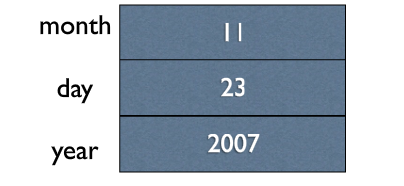声明结构的形式
struct point{ int x; int y; }; struct point p1,p2;//p1,p2都是point,里面有x和y的值。
struct point{ int x; int y; }p1,p2; //p1,p2都是point,里面有x和y的值。
struct { int x; int y; }p1,p2; //p1,p2都是一种无名结构,里面有x和y。
对于第一种和第二种形式,都声明了结构point。但是第三种形式没有声明point,只是定义了两个变量。
结构变量
struct date today; today.month=06; today.day=19; today.year=2005;

结构初始化
#include<stdio.h> struct date{ int month; int day; int year; }; int main() { struct date today={07,31,2014 }; struct date thismonth={.month=7,.year=2014 }; printf("Today’s date is: %i-%i-%i.\n",today.year,today.month,today.day); printf("This month is: %i-%i-%i.\n",thismonth.year,thismonth.month,thismonth.day); return 0; }
结构成员
(1)结构和数组有点像。
(2)数组用[]运算符和下标访问其成员。
a[0]=10;
(3)结构用.运算符和名字访问其成员。
today.day
student.firstName
p1.x p1.y //当p1表示的是结构体名时,x,y表示变量名
结构运算
(1)要访问整个结构,直接用结构变量的名字。
(2)对于整个结构,可以做赋值、取地址,也可以传递给函数参数
p1=(struct point){5,10}; //相当于p1.x=5;p2.y=10;
p1=p2; //相当于p1.x=p2.x;p1.y=p2.y;
数组无法做这两种运算
复合字面量
today=(struct date){9,25,2004};
today=(struct date){.month=9,.day=25,.year=2004};
结构指针
和数组不同,结构变量的名字并不是结构变量的地址,必须使用&运算符
struct date *pDate=&today;